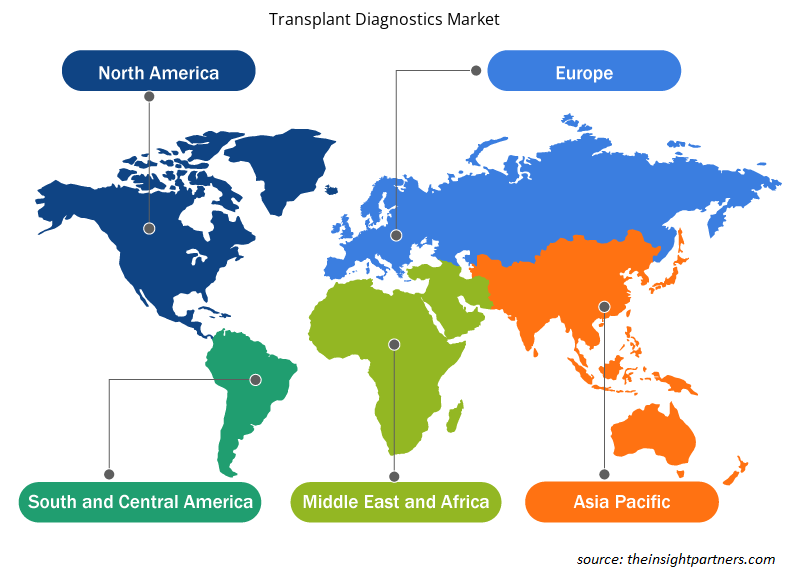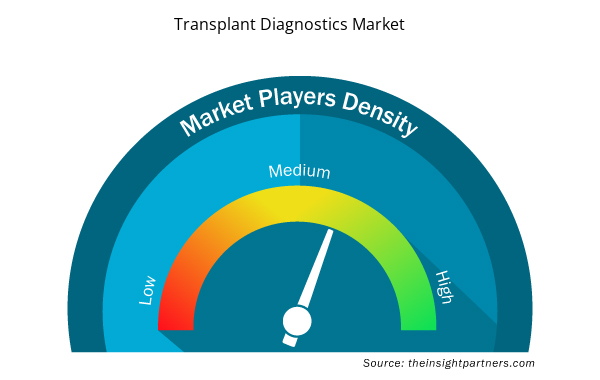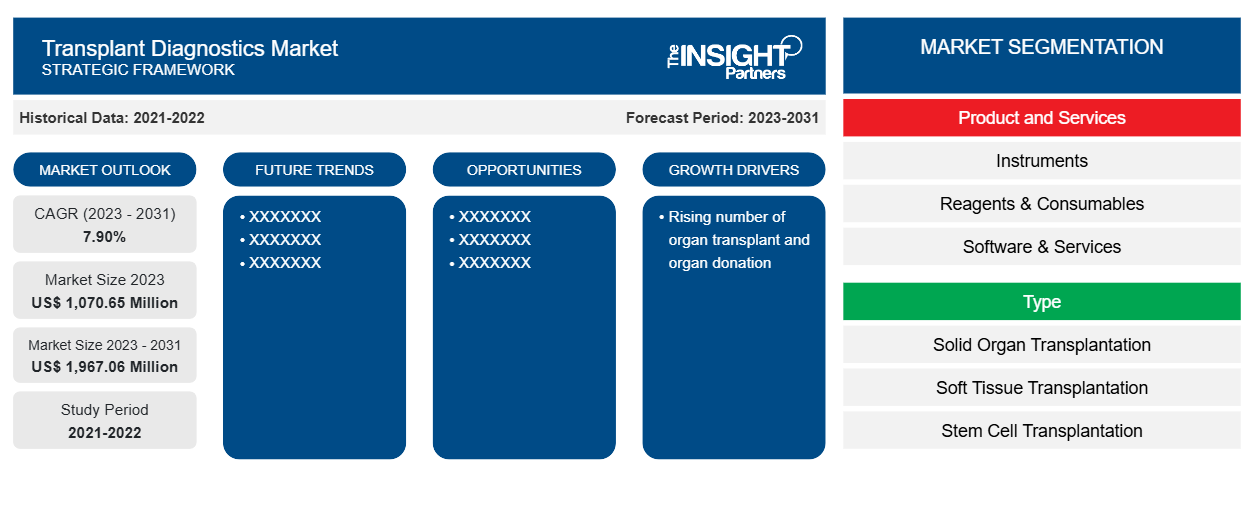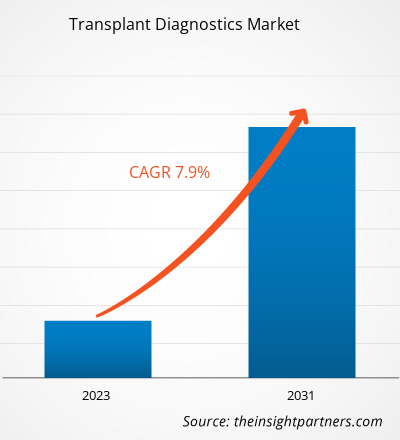移植診断市場の規模は、2023年の10億7,065万米ドルから2031年には19億6,706万米ドルに達すると予測されています。市場は2023年から2031年にかけて7.90%のCAGRを記録すると予想されています。肝臓、腎臓、心臓、肺の移植など、臓器移植手術の世界的な増加により、移植診断の需要が促進され、市場全体の成長が促進されると予想されています。さらに、移植手術を必要とする臓器不全や慢性疾患の蔓延が、移植診断市場の主要トレンドであり続けると思われます。
移植診断市場分析
移植は、腎臓疾患を患い、慢性透析療法を受けている患者にとって最も好ましい治療法の 1 つです。また、心臓病や肝臓病を患っている患者にとっても、移植は実行可能な選択肢です。企業がより優れた HLA タイピング技術、抗体モニタリング、機器、ソフトウェアを開発してきたため、世界中の診断は大幅に改善されました。この技術は、臓器移植時の診断に使用されています。移植手順の進歩は、市場成長の大きな機会を提供します。
移植診断市場の概要
北米は移植診断市場の成長において最大の市場であり、米国が最大の市場シェアを占め、カナダがそれに続いています。北米での成長は、この地域での臓器移植件数の増加と臓器不全の有病率の上昇によって特徴付けられます。United Network for Organ Sharing.orgで公開されたデータによると、2023年に米国で約46,630件の移植手術が行われたと推定されています。同様に、donatelife.netによると、2022年に米国は歴史的な節目を迎え、世界のどの国と比較しても約100万件の臓器移植を達成しました。2023年には、23,000人以上のドナーがレシピエントとその家族に新しい命をもたらしました。さらに、約10万人が命を救う臓器移植の待機リストに載っています。したがって、国内の臓器移植件数の増加は、今後数年間で市場の成長を牽引する可能性があります。
要件に合わせてレポートをカスタマイズする
このレポートの一部、国レベルの分析、Excelデータパックなど、あらゆるレポートを無料でカスタマイズできます。また、スタートアップや大学向けのお得なオファーや割引もご利用いただけます。
- このレポートの主要な市場動向を入手してください。この無料サンプルには、市場動向から見積もりや予測に至るまでのデータ分析が含まれます。
移植診断市場の推進要因と機会
臓器移植手術を必要とする慢性疾患の発生率上昇は市場に有利
臓器移植の需要の高まりは、糖尿病や腎臓病などの慢性疾患の蔓延によって補完され、移植診断の市場をさらに推進しています。たとえば、カリフォルニア大学サンフランシスコ校が発表したデータによると、米国では約 75 万人、世界中では推定 200 万人の患者が毎年腎不全に罹患しています。したがって、これらの臓器不全により、米国でのドナー腎臓の需要も年間 8% 増加しています。日本、台湾、メキシコ、米国、ベルギーなどの国では、腎不全の罹患率が最も高くなっています。
AIと機械学習の統合 - 移植診断市場におけるチャンス
人工知能 (AI) と機械学習アルゴリズムの組み合わせは、移植診断市場で有望な結果を示しており、患者の転帰を改善し、データ分析を高速化し、診断精度を高めて市場の拡大につながる可能性があります。移植の需要は、人口の高齢化、慢性疾患の有病率の上昇、より幅広い患者が移植の対象となることを可能にする医療機器の進歩など、さまざまな主要な要因により高まっています。
移植診断市場レポートのセグメンテーション分析
移植診断市場分析の導出に貢献した主要なセグメントは、製品とサービス、タイプ、テクノロジー、およびエンドユーザーです。
- 製品とサービスに基づいて、移植診断市場は、機器、試薬と消耗品、ソフトウェアとサービスに分類されます。機器、試薬と消耗品、ソフトウェアとサービス。試薬と消耗品は2023年に市場で最大のシェアを占めました。ソフトウェアとサービスは、2023年から2031年の予測期間にわたって最高のCAGRを記録しました。CAGR over the forecast period 2023-2031.
- タイプ別に見ると、市場は固形臓器移植、軟部組織移植、幹細胞移植に分類されます。固形臓器移植セグメントは2023年に市場で最大のシェアを占めました。
- 技術別に見ると、市場は分子アッセイと非分子アッセイに分類されます。分子アッセイセグメントは、予測期間中に最も高い CAGR を記録すると予想されます。
- エンドユーザー別に見ると、市場は病院と移植センター、研究室と学術機関、独立参照研究所に分類されます。病院と移植センターのセグメントは、2023年に市場で最大のシェアを占めました。
移植診断市場シェア分析(地域別)
移植診断市場レポートの地理的範囲は、主に北米、アジア太平洋、ヨーロッパ、中東およびアフリカ、南米および中米の 5 つの地域に分かれています。
北米は移植診断市場を支配してきました。市場の成長は、臓器不全の有病率の増加に起因し、臓器移植手順とともに臓器提供数の増加が地域の市場成長を促進しています。たとえば、米国の非営利団体である臓器提供組織協会(AOPO)が発表したデータによると、2021年1月には、2020年に12,500人以上が1つ以上の臓器を提供し、死亡したドナーから提供された臓器の数は36,500を超え、前年比で約2%増加しています。さらに、死者からの臓器は過去7年間で33,000人以上の命を救っています。
したがって、臓器提供の増加により、移植診断検査の増加の必要性が生まれ、市場の成長が促進されます。
移植診断市場の地域別分析
予測期間を通じて移植診断市場に影響を与える地域的な傾向と要因は、Insight Partners のアナリストによって徹底的に説明されています。このセクションでは、北米、ヨーロッパ、アジア太平洋、中東およびアフリカ、南米および中米にわたる移植診断市場のセグメントと地理についても説明します。

- 移植診断市場の地域別データを入手
移植診断市場レポートの範囲
| レポート属性 | 詳細 |
|---|---|
| 2023年の市場規模 | 10億7,065万米ドル |
| 2031年までの市場規模 | 19億6,706万米ドル |
| 世界のCAGR(2023年~2031年) | 7.90% |
| 履歴データ | 2021-2022 |
| 予測期間 | 2023-2031 |
| 対象セグメント | 製品・サービス別
|
| 対象地域と国 | 北米
|
| 市場リーダーと主要企業プロフィール |
|
市場プレーヤーの密度:ビジネスダイナミクスへの影響を理解する
移植診断市場は、消費者の嗜好の変化、技術の進歩、製品の利点に対する認識の高まりなどの要因により、エンドユーザーの需要が高まり、急速に成長しています。需要が高まるにつれて、企業は提供内容を拡大し、消費者のニーズを満たすために革新し、新たなトレンドを活用し、市場の成長をさらに促進しています。
市場プレーヤー密度とは、特定の市場または業界内で活動している企業または会社の分布を指します。これは、特定の市場スペースに、その市場規模または総市場価値に対してどれだけの競合相手 (市場プレーヤー) が存在するかを示します。
移植診断市場で事業を展開している主要企業は次のとおりです。
- バイオ・ラッド・ラボラトリーズ、
- ホロジック、
- イルミナ株式会社
- サーモフィッシャーサイエンティフィック、
- キアゲンNV
- オミクソン株式会社
免責事項:上記の企業は、特定の順序でランク付けされていません。

- 移植診断市場のトップキープレーヤーの概要を入手
移植診断市場のニュースと最近の動向
移植診断市場は、主要な企業出版物、協会データ、データベースを含む一次調査および二次調査後の定性的および定量的データを収集することによって評価されます。以下は、移植診断市場の動向の一覧です。
- サーモフィッシャーサイエンティフィックは、米国組織適合性免疫遺伝学会(ASHI)年次会議で、移植診断ポートフォリオに 2 つの新製品を追加しました。(出典:サーモフィッシャーサイエンティフィック、プレスリリース/企業ウェブサイト/ニュースレター、2023 年 10 月)
- 輸血および移植診断に注力する企業であるImmucor, Inc.は、移植診断ポートフォリオへの2つの追加を発表し、組織適合性分野における新たな進歩への継続的な取り組みを示しました。(出典: Immucor、プレスリリース/企業ウェブサイト/ニュースレター、2022年3月)
- BiocartisとOphiomicsは、肝移植の恩恵を受ける患者を特定するための予後遺伝子発現シグネチャー検査であるHepatoPredictの商業化に注力するために提携しました(出典:Biocartis、プレスリリース/企業ウェブサイト/ニュースレター、2022年3月)
移植診断市場レポートの対象範囲と成果物
「移植診断市場の規模と予測(2021〜2031年)」レポートでは、以下の分野をカバーする市場の詳細な分析を提供しています。
- 対象範囲に含まれるすべての主要市場セグメントの世界、地域、国レベルでの市場規模と予測
- 市場の動向(推進要因、制約、主要な機会など)
- 今後の主な動向
- 詳細なPEST/ポーターの5つの力とSWOT分析
- 主要な市場動向、主要プレーヤー、規制、最近の市場動向を網羅した世界および地域の市場分析
- 市場集中、ヒートマップ分析、主要プレーヤー、最近の動向を網羅した業界の状況と競争分析
- 詳細な企業プロフィール
- 過去2年間の分析、基準年、CAGRによる予測(7年間)
- PEST分析とSWOT分析
- 市場規模価値/数量 - 世界、地域、国
- 業界と競争環境
- Excel データセット



Report Coverage
Revenue forecast, Company Analysis, Industry landscape, Growth factors, and Trends

Segment Covered
This text is related
to segments covered.

Regional Scope
North America, Europe, Asia Pacific, Middle East & Africa, South & Central America

Country Scope
This text is related
to country scope.
Trends and growth analysis reports related to Life Sciences : READ MORE..
The Insight Partners performs research in 4 major stages: Data Collection & Secondary Research, Primary Research, Data Analysis and Data Triangulation & Final Review.
- Data Collection and Secondary Research:
As a market research and consulting firm operating from a decade, we have published and advised several client across the globe. First step for any study will start with an assessment of currently available data and insights from existing reports. Further, historical and current market information is collected from Investor Presentations, Annual Reports, SEC Filings, etc., and other information related to company’s performance and market positioning are gathered from Paid Databases (Factiva, Hoovers, and Reuters) and various other publications available in public domain.
Several associations trade associates, technical forums, institutes, societies and organization are accessed to gain technical as well as market related insights through their publications such as research papers, blogs and press releases related to the studies are referred to get cues about the market. Further, white papers, journals, magazines, and other news articles published in last 3 years are scrutinized and analyzed to understand the current market trends.
- Primary Research:
The primarily interview analysis comprise of data obtained from industry participants interview and answers to survey questions gathered by in-house primary team.
For primary research, interviews are conducted with industry experts/CEOs/Marketing Managers/VPs/Subject Matter Experts from both demand and supply side to get a 360-degree view of the market. The primary team conducts several interviews based on the complexity of the markets to understand the various market trends and dynamics which makes research more credible and precise.
A typical research interview fulfils the following functions:
- Provides first-hand information on the market size, market trends, growth trends, competitive landscape, and outlook
- Validates and strengthens in-house secondary research findings
- Develops the analysis team’s expertise and market understanding
Primary research involves email interactions and telephone interviews for each market, category, segment, and sub-segment across geographies. The participants who typically take part in such a process include, but are not limited to:
- Industry participants: VPs, business development managers, market intelligence managers and national sales managers
- Outside experts: Valuation experts, research analysts and key opinion leaders specializing in the electronics and semiconductor industry.
Below is the breakup of our primary respondents by company, designation, and region:

Once we receive the confirmation from primary research sources or primary respondents, we finalize the base year market estimation and forecast the data as per the macroeconomic and microeconomic factors assessed during data collection.
- Data Analysis:
Once data is validated through both secondary as well as primary respondents, we finalize the market estimations by hypothesis formulation and factor analysis at regional and country level.
- Macro-Economic Factor Analysis:
We analyse macroeconomic indicators such the gross domestic product (GDP), increase in the demand for goods and services across industries, technological advancement, regional economic growth, governmental policies, the influence of COVID-19, PEST analysis, and other aspects. This analysis aids in setting benchmarks for various nations/regions and approximating market splits. Additionally, the general trend of the aforementioned components aid in determining the market's development possibilities.
- Country Level Data:
Various factors that are especially aligned to the country are taken into account to determine the market size for a certain area and country, including the presence of vendors, such as headquarters and offices, the country's GDP, demand patterns, and industry growth. To comprehend the market dynamics for the nation, a number of growth variables, inhibitors, application areas, and current market trends are researched. The aforementioned elements aid in determining the country's overall market's growth potential.
- Company Profile:
The “Table of Contents” is formulated by listing and analyzing more than 25 - 30 companies operating in the market ecosystem across geographies. However, we profile only 10 companies as a standard practice in our syndicate reports. These 10 companies comprise leading, emerging, and regional players. Nonetheless, our analysis is not restricted to the 10 listed companies, we also analyze other companies present in the market to develop a holistic view and understand the prevailing trends. The “Company Profiles” section in the report covers key facts, business description, products & services, financial information, SWOT analysis, and key developments. The financial information presented is extracted from the annual reports and official documents of the publicly listed companies. Upon collecting the information for the sections of respective companies, we verify them via various primary sources and then compile the data in respective company profiles. The company level information helps us in deriving the base number as well as in forecasting the market size.
- Developing Base Number:
Aggregation of sales statistics (2020-2022) and macro-economic factor, and other secondary and primary research insights are utilized to arrive at base number and related market shares for 2022. The data gaps are identified in this step and relevant market data is analyzed, collected from paid primary interviews or databases. On finalizing the base year market size, forecasts are developed on the basis of macro-economic, industry and market growth factors and company level analysis.
- Data Triangulation and Final Review:
The market findings and base year market size calculations are validated from supply as well as demand side. Demand side validations are based on macro-economic factor analysis and benchmarks for respective regions and countries. In case of supply side validations, revenues of major companies are estimated (in case not available) based on industry benchmark, approximate number of employees, product portfolio, and primary interviews revenues are gathered. Further revenue from target product/service segment is assessed to avoid overshooting of market statistics. In case of heavy deviations between supply and demand side values, all thes steps are repeated to achieve synchronization.
We follow an iterative model, wherein we share our research findings with Subject Matter Experts (SME’s) and Key Opinion Leaders (KOLs) until consensus view of the market is not formulated – this model negates any drastic deviation in the opinions of experts. Only validated and universally acceptable research findings are quoted in our reports.
We have important check points that we use to validate our research findings – which we call – data triangulation, where we validate the information, we generate from secondary sources with primary interviews and then we re-validate with our internal data bases and Subject matter experts. This comprehensive model enables us to deliver high quality, reliable data in shortest possible time.


 このレポートの無料サンプルを入手する
このレポートの無料サンプルを入手する